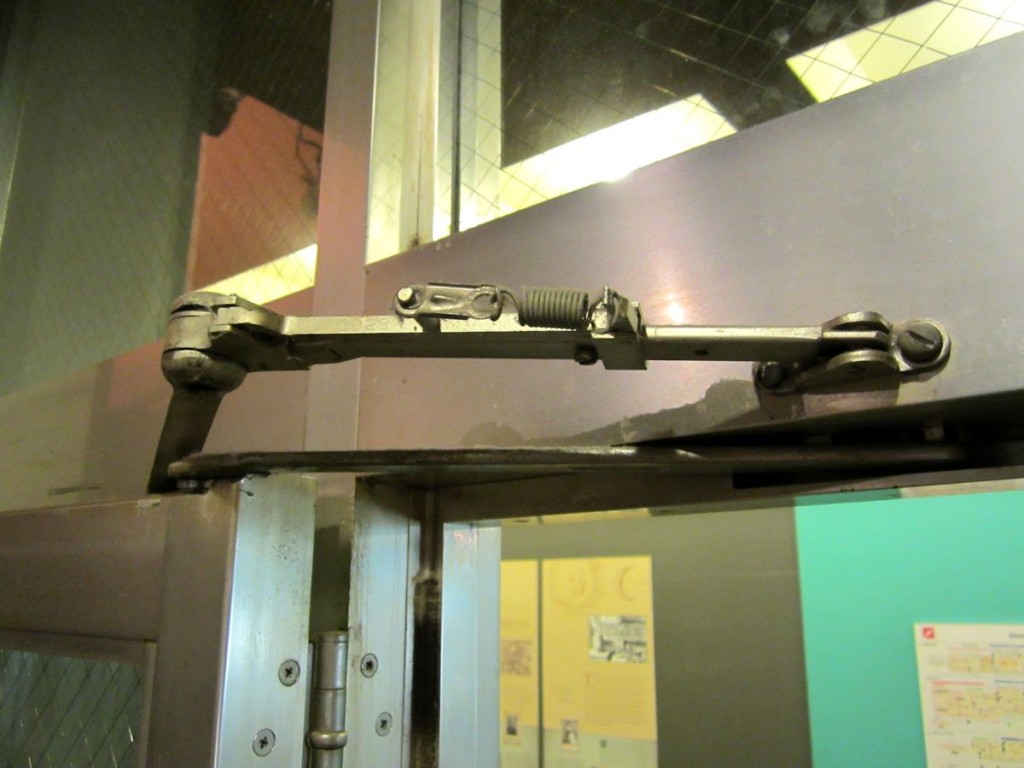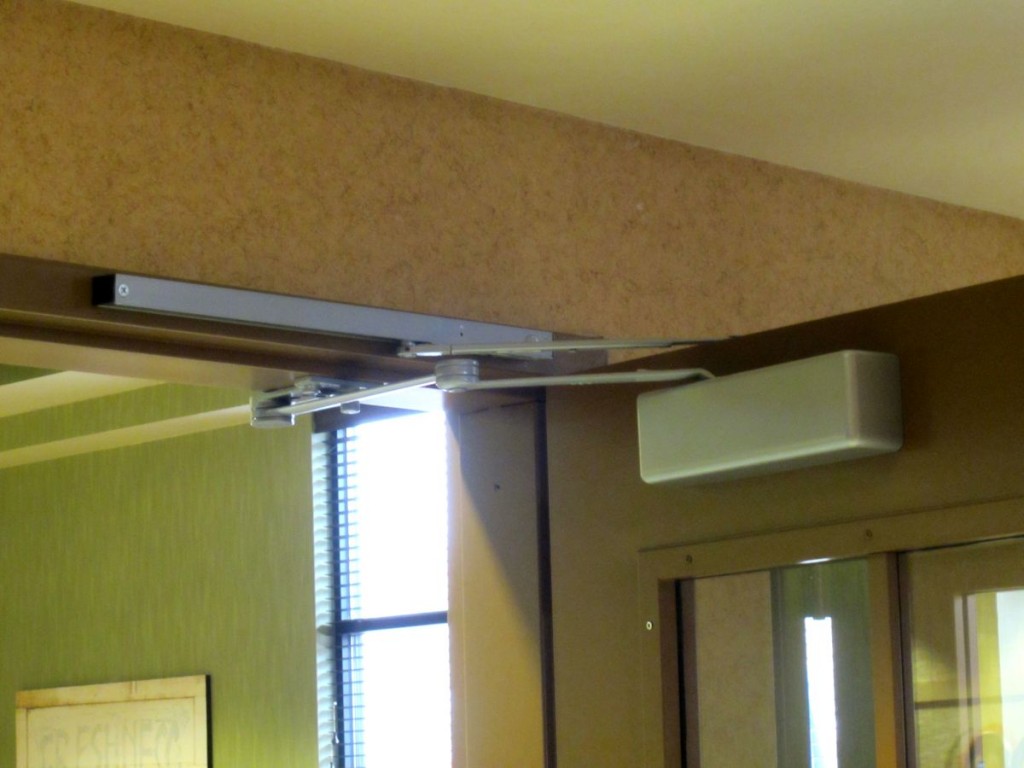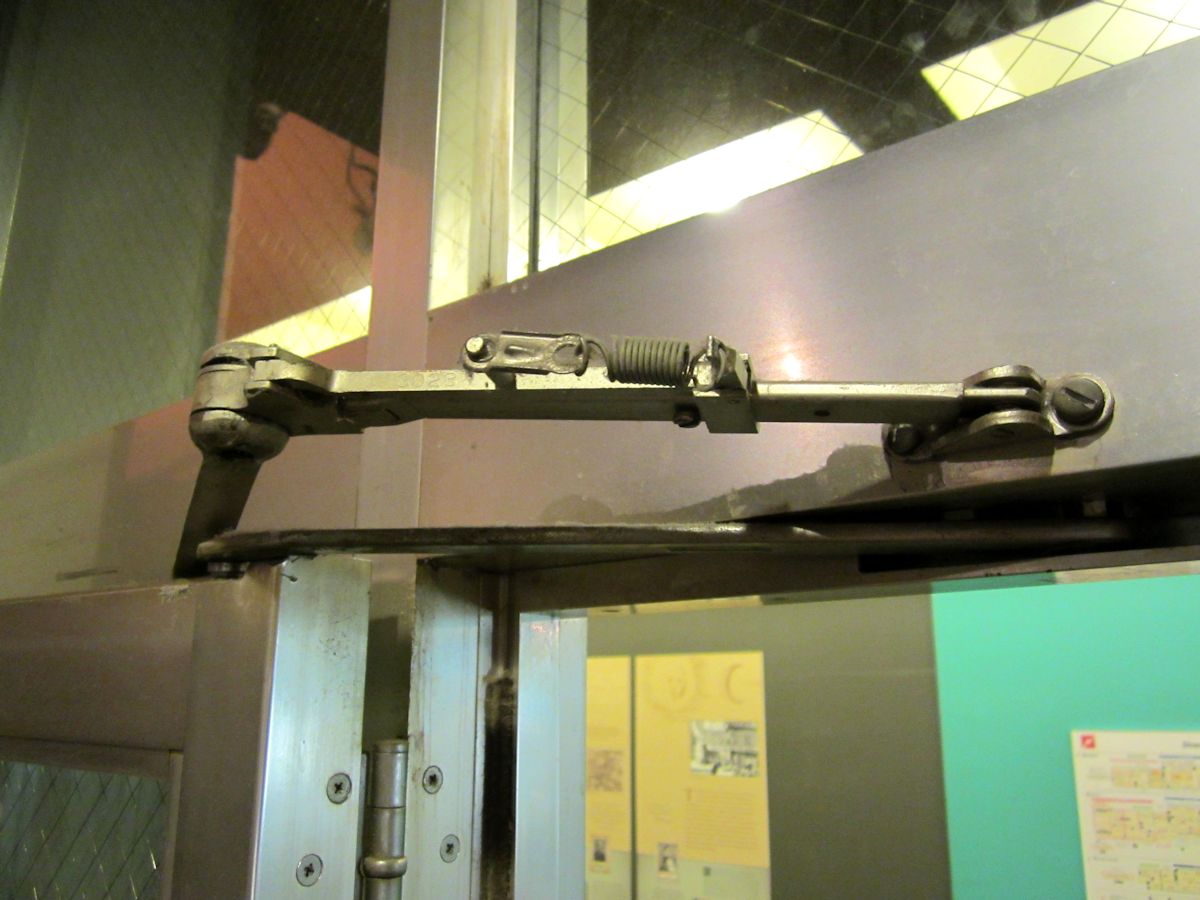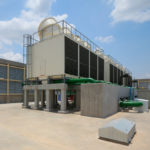This post was printed in Doors & Hardware
 In the days before hold-open devices on fire doors and smoke doors were actuated by smoke detectors, fusible link closer arms were often used to hold open doors that were required to close if a fire occurred. Fusible link closer arms incorporate a link made from pieces of metal held together by solder that is designed to melt when it reaches a certain temperature, releasing the hold-open and allowing the door closer to close the door. The problem with using a fusible link for this purpose is that smoke and toxic gases can pass through the door opening before the fusible link becomes hot enough to release the door. This defeats the purpose of the fire door or smoke door, which is meant to compartmentalize the building and protect the means of egress to provide an escape route for building occupants.
In the days before hold-open devices on fire doors and smoke doors were actuated by smoke detectors, fusible link closer arms were often used to hold open doors that were required to close if a fire occurred. Fusible link closer arms incorporate a link made from pieces of metal held together by solder that is designed to melt when it reaches a certain temperature, releasing the hold-open and allowing the door closer to close the door. The problem with using a fusible link for this purpose is that smoke and toxic gases can pass through the door opening before the fusible link becomes hot enough to release the door. This defeats the purpose of the fire door or smoke door, which is meant to compartmentalize the building and protect the means of egress to provide an escape route for building occupants.
I’m asked quite often if fusible link arms are still allowed to be used on fire doors. The logical place to start is NFPA 80 – Standard for Fire Doors and Other Opening Protectives. Fusible links are addressed by NFPA 80, especially with regard to sliding fire doors, and the standard does not prohibit their use for swinging doors. Door operation is divided into three categories within the standard – self-closing, automatic-closing, and power-operated doors.
- Self-closing fire doors are equipped with a closing device to close and latch the door each time it is opened. A door with a door closer and no hold-open device is self-closing. A door with spring hinges would also be considered self-closing, although spring hinges may not reliably close and latch the door and will not provide the control that a door closer does. Listed spring hinges are allowed by the model codes and referenced standards.
- Automatic-closing fire doors have a closing device and a means of holding the door open that will release and allow the door to close if there is a fire. Some automatic-closing devices allow the door the swing freely as if the door is not equipped with a closer, but during a fire the door becomes self-closing. The means of holding open the door may be part of a closer/holder mechanism, or may be separate from the closing device. While NFPA 80 allows automatic-closing devices to be activated by a fusible link or fire/smoke detector, the model codes require automatic-closing fire doors in most locations to be activated by smoke detection (see below).
- Power-operated fire doors are equipped with automatic operators to open the door automatically. NFPA 80 requires the automatic operators on fire doors to be disconnected automatically if there is a fire, allowing the door to close. The door must close and latch regardless of whether it is opened manually or if there is a power failure. When considering automating a fire door because the door does not meet the accessibility requirements for a manually-operated door, it’s important to note that the door will not operate automatically during a fire or fire alarm, as the operator must be deactivated. This likely means that an automatic operator is not a solution to the lack of maneuvering clearance on the egress side of a fire door.
Back to the original question about fusible links…a fire door with a hold-open mechanism that allows the door to close during a fire would be an automatic-closing door. In the section on door operations NFPA 80 isn’t very specific about whether a fusible link would be acceptable. Let’s check Chapter 3 – Definitions:
3.3.6 Automatic-Closing Device. A device that causes the door or window to close when activated by a fusible link or detector.
3.3.7 Automatic-Closing Door. A door that normally is open but that closes when the automatic-closing device is activated.
Because an automatic-closing door is defined as a door with an automatic-closing device, and the definition of an automatic-closing device includes a fusible link as an option, my interpretation is that NFPA 80 would permit a fusible link closer arm. But before you stock up on fusible link closers or specify them for your next project, we need to consider the International Building Code (IBC) and NFPA 101 – The Life Safety Code.
 The IBC requires fire doors and smoke doors in certain locations to be smoke-activated; automatic-closing by the actuation of smoke detectors or loss of power to the detector or hold-open. The code also requires smoke-activated doors to begin closing within 10 seconds after the smoke detector is actuated. According to the 2021 and 2018 editions of the IBC (2021, 2018 – 716.2.6.6), this applies to automatic-closing swinging fire doors and smoke doors in the following locations:
The IBC requires fire doors and smoke doors in certain locations to be smoke-activated; automatic-closing by the actuation of smoke detectors or loss of power to the detector or hold-open. The code also requires smoke-activated doors to begin closing within 10 seconds after the smoke detector is actuated. According to the 2021 and 2018 editions of the IBC (2021, 2018 – 716.2.6.6), this applies to automatic-closing swinging fire doors and smoke doors in the following locations:
- walls separating incidental use areas (see Section 509)
- fire walls
- fire barriers
- fire partitions
- smoke barriers
- smoke partitions
- shaft enclosures
- waste and linen chutes – discharge openings and access and discharge rooms
Note that this list has changed from the previous editions of the IBC (2015, 2012 – 716.5.9.3, 2009 – 715.4.8.3), which require the following automatic-closing swinging fire doors and smoke doors to be smoke-activated:
- doors installed across a corridor
- doors that protect openings in exits or corridors required to be of fire-resistance-rated construction or in walls that are capable of resisting the passage of smoke
- doors in smoke barriers, fire partitions, fire walls, shaft enclosures
- doors in refuse and laundry chutes and access and termination rooms
- certain doors in underground buildings including walls for compartmentation and elevator lobby walls, and
- doors in smoke partitions
NFPA 101 – The Life Safety Code permits automatic-closing doors in buildings of low or ordinary hazard contents or where approved by the Authority Having Jurisdiction (AHJ). The NFPA 101 requirements for automatic-closing doors are:
- the door becomes self-closing upon release of the hold-open mechanism,
- the device can be manually released and will then become self-closing,
- the automatic releasing mechanism is activated by smoke detectors in accordance with NFPA 72 – National Fire Alarm and Signaling Code,
- the hold-open mechanism is released upon loss of power to the device, and
- when one stair door is released by smoke detection, all of the door leaves serving that stair will close.
More information about detectors, including the locations where they must be installed, can be found in NFPA 72, as well as NFPA 80. One of the common questions with regard to NFPA 72 is whether smoke detectors used for door release must be monitored, as some hold-open devices include an integral smoke detector that is not typically monitored by the building’s smoke detection system.
I had to get some assistance from NFPA on this question, but I was assured that these smoke detectors are not required to be monitored by the system. This is spelled out clearly in paragraph 21.8.2 of NFPA 72 (2016, 2013, and 2010 editions):
21.8.2 All detection devices used for door hold-open release service shall be monitored for integrity in accordance with Section 12.6 (2016 and 2013 editions) /10.17 (2010 edition).
Exception: Smoke detectors used only for door and shutter release and not for open area protection.
NFPA 72 Handbook: Monitoring for integrity is not required for detectors integral to the door assembly, or stand-alone detectors not connected to the fire alarm system.
If you’ve read NFPA 72, you may have noticed the next paragraph, which seems to contradict the exception above, but because Class D circuits are used, the referenced sections do not require the detectors to be monitored, as explained in the NFPA 72 Handbook:
21.8.3 All door and shutter hold-open release and integral door and shutter release and closure devices used for release service shall be monitored for integrity in accordance with Section 12.6 (2016 edition) / 21.2 (2013 and 2010 editions).
Exception added in the 2016 edition: Pathways installed as Class D circuits in accordance with 12.3.4.
NFPA 72 Handbook: Generally, magnetic door release appliances are installed so that they release on loss of power. Where Class D circuits or pathways are used in accordance with 21.2.6, fail-safe operation is provided and monitoring for integrity is not required.
In the 2019 edition of NFPA 72, the paragraphs addressing these requirements were modified slightly:
21.9.2 Other than smoke detectors used only for door and shutter release and not for open area protection, all detection devices used for door and shutter hold-open release service shall be monitored for integrity in accordance with Section 12.6.
21.9.3 Unless installed as Class D circuits in accordance with 12.3.4, all door and shutter hold-open release and integral door and shutter release and closure devices used for release service shall be monitored for integrity in accordance with Section 12.6.
The codes in your jurisdiction may vary so check the local requirements, but the bottom line is that there are very few locations (almost none) where fusible link closer arms are currently acceptable for use on fire doors or smoke doors. This is to protect the means of egress from becoming compromised by smoke prior to the release of the fusible link. In locations where a hard-wired electronic hold-open unit is not feasible, a battery-operated unit with an integral smoke detector may be a good solution.
You need to login or register to bookmark/favorite this content.







How timely! 🙂 Great job going into detail on whether fusible links are allowed. If we only look at one standard (NFPA 80), we would think they are allowable. Thus, it isn’t that easy, and we need to consult both IBC and NFPA 101, and we see they are not allowed. Do you think NFPA 80 will eventually take out the reference to fusible links, or does that need to stay because the statement applies to different types of doors?
You were my inspiration for this one! I don’t know if 80 will change…probably not.
You can propose a change to NFPA 80 when it is in the Public Input phase. It just closed June 1 2022 but will be open shortly after the next edition is published. NFPA.org/80 and look at the next edition.
Thanks Liane! I work with the BHMA Codes & Government Affairs Committee on proposals, but we have been focusing on the more crucial ones over the last few editions.
– Lori
what is your read on this section out of the 2009 ibc??
715.4.8.2 Automatic-closing fire door assemblies.
Automatic-closing fire door assemblies shall be
self-closing in accordance with NFPA 80.
Well, it’s a little confusing and redundant, but I interpret it to mean that once the smoke detector releases the hold-open unit, the door closes.
and are there places not listed in 715.4.8.3 that could use something besides a smoke detector??
But that is a pretty long list, not sure why the code does not say “All”
If you can think of a place that’s not on that list, in my opinion you can use a fusible link arm.
Can electronic Hold open closers meet ADA 5lbs opening force.
Hi Dewain –
I’m not sure whether there are any that do. Since these closers are used on fire doors, the doors are not typically required to open with 5 pounds of force. The LCN 4310 MESF has a swing-free arm, so the door “swings free” after the hold-open has been engaged. This would meet the 5-pound requirement except for after the hold-open has been released and the door has to be opened once to be re-set. This operation would take more than 5 pounds of force, but then the door would swing free until it is released from hold-open and has to be re-set again. It’s not the right product for all applications, but it’s great for some locations. There’s more info here: https://idighardware.com/2013/12/swing-free-in-school/.
– Lori
It appears that neither LCN nor GJ offer a detectored unit anymore. Was this because of a code change or demand?
Hi Bill –
I’m pretty sure the detectored units were discontinued when a code change was made years ago that required detectors to be monitored by the overall system. The code has since been modified/clarified (there’s some info toward the end of the article) but by that time separate detectors had become the norm.
– Lori